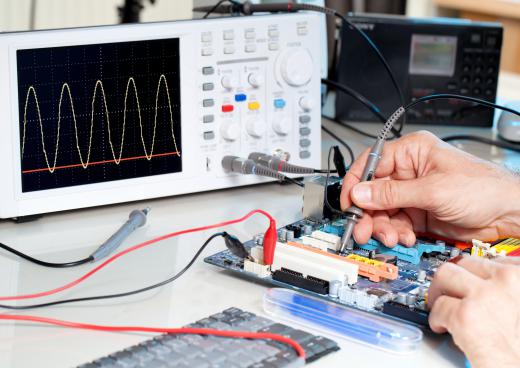What is a Tone Generator?
A tone generator, also known as a signal generator, can be described in at least two contexts: electronic audio acoustics and equipment testing and setup, or informational signals, commonly associated with a telephone system. In each case, electrically generated audio pulses are sent to specific components. In the case of audio equipment testing, frequency response and sound evaluation are noted, and the acoustic properties of a studio or hall may be determined. With a telephone system, the dial tone, busy signal, and ring tone are the result of this pulsed tone generation.
When testing audio equipment, a tone generator sends out a sound pulse or test tone, either solid or wavering, at specified octaves and frequencies. This can be measured using either an oscilloscope, when testing equipment, or with a sound-level meter when determining the acoustical properties of a room or certain audio receivers.

These devices will not only generate a tone, but may also be used to replicate certain electronically produced or recorded audio signals. The results of the signals are described variously as white noise or pink noise, depending on the energy level of the sound pulse.
The sound pulses may be seen on an oscilloscope as sine waves, a sound-wave pattern generated at 20 hertz (Hz) to 20 kilohertz (kHz), the basic range of audio frequency. The variations in the highs and lows of the sine wave, as well as the distance between them, determine the effectiveness of audio equipment, both in receiving and producing certain sounds along predetermined points within the audio frequency range.

Other representations of tone pulsations and frequency generation include a sawtooth wave, a triangle wave, a square wave, and various others. These particular representations indicate loudness, harmonics, and/or decreasing or increasing energy levels of the audio impulses. These impulses, of a specific tonal quality and energy, may be visually interpreted on the oscilloscope through the depiction of a particular pattern. One pattern that combines harmonics and pulse energy will resemble a series of triangles, another will give a sawtooth pattern, another squares, and so on.

As such, in its most frequently used context, a tone generator tests the various frequency-response qualities of sound reproduction devices. It is also used to evaluate the acoustics of the room where the signals are heard so that listeners can get the most pleasure. In its other, less common context, a person can just pick up the telephone to experience its result.
AS FEATURED ON:
AS FEATURED ON:













Discussion Comments
A friend of mine could dial a telephone using only his voice. It is my understanding that telephones do not actually register the number pressed on the telephone, they register the corresponding tone produced by each individual number. My friend had memorized the various tone (He was a smart guy with a great voice) and he could dial just about any number you wanted just by repeating the tones during the dial tone. The first time I saw it I just about fell out of my seat. Even though it doesn't rise above the level of being a party trick it is still really impressive.
I have a good friend that set up a recording studio in his basement about 5 years ago. I didn't have any experience with sound engineering, but I had some carpentry skills and helped him with a lot of the construction.
Once we got the basic frame of the space installed it was time to break out the tone generator. It was a little device not much bigger than a cell phone. It made a single repeated sound that was familiar but not something I could ever put my finger on. We generated tones in dozens of places around the room and my friend tracked the response using a computer program that he had access to.
We used the data generated to install sound muffling devices around the room. The idea was that these would dull the sound of the music on the outside of the studio while still maintaining the acoustic qualities of the room. Its hard to say if we did it right but the recording that have come out of that studio sound great.
Post your comments